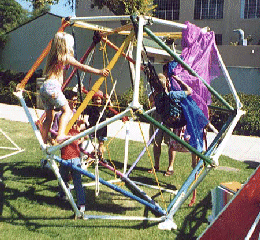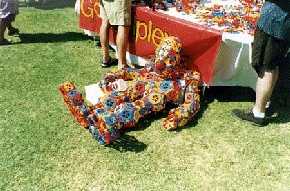
On the Fuller Centennial 1995
a Personal Account
by Kirby Urner
Part III
Upon the conclusion of the opening ceremonies at Mandeville
Auditorium at UCSD (see Part I), GENI
logistics crews swung into action, working all through the night to
get the video projectors, screens, control center, and computers,
transported to SDSU, the site for the closing ceremonies Sunday
evening, and four World Games in the meantime. Conferees selected a
World Game of their choice upon registering (the final one was by
invitation) and received "boarding passes" to this 3.5 hour
participatory experience.
World Game, a tiny NGO based in Philadelphia, does a lot with a little. The gymnasium-floor-covering maps have to be assembled by hand from piles of jet navigation charts. And since the charts show the oceans as white, and since people expect a blue ocean, the map-makers have to cut along miles of coastline, following the continental shelf, pasting the cut-outs against a blue background. Once launched into service, each map has a grueling career of world travel ahead of it, with all the hazards this may entail, such as getting lost. American Airlines managed to lose the map headed to the Earth Summit in Rio, for example, triggering a last minute scramble to express-ship a backup. The misrouted map turned up later, in a warehouse someplace.
Because I had a baby strapped to my back who was unhappy unless I kept moving, the event organizers realized I'd participate most effectively as a roving reporter, assigned to wander about the map interviewing the list of regions on my beat. I and my two journalist collegues were issued Media hats (others wore hats labeled "Commercial Bank," "UNESCO," etc. or stamped with the name of their region). As Media, our instructions were to distill the chaotic events of each round of play into pithy news stories, and to inject a note of levity into our reports if possible.
Chuck and Medard kept up a steady patter throughout the event, mixing instructions for play, historical data going back 4.5 billion years, statistical data about trends and projections. The video projectors were kept busy, illustrating the ongoing exponential surges in technology, population, urbanization, and the spread of AIDS.

If only World Game itself would grow exponentially. A gym sized map assembled from satellite photographs, instead of jet navigation charts, would show urban areas, cultivation, even some of the pollution where waterways meet the sea-but a map like this would take a much bigger budget to produce. And for all its multimedia sophistication, World Game needs stronger presentation graphics, both during the game and for sharing with potential sponsors. The current format aims at providing a wild ride, with memorable highs and lows, but a stronger metaphysics is needed to create a space that really supports this. A Disney-style pavilion providing a series of experiences by means of successive chambers, and following the current logic of alternating periods of full-body participation with more passive periods for contemplation and rapid-fire exposure to content, might do the job; and prove a major attraction for serious-minded individuals wanting to train themselves to play hard. The question is whether the corporate cultures that would need to converge on the World Game to create such high-powered curriculum artifacts have the integrity to present uncorrupted information. Given the number of watchdogs and critics any such supercharged World Game would engender, its founders chief among them, the chances of creating a fairly undiluted immersion experience in up-to-the-minute global data are high.

We returned to our rented Expo for a final visit to Balboa Park. Long tables covered with toothpicks and marshmellows gave kids and adults a chance to make some homey geometric structures. Across the lawn, a glitzier attraction featured huge numbers of colorful plastic Googel Plex pieces strewn about under a tent, plus exhibits of completed works: a scale model of Biosphere II (one of whose architects was present at the conference); four foot high robot-looking creatures; and huge polyhedral constructions, both skeletal (see-through) and opaque. Those who wished were of course encouraged to purchase a box of pieces to go.
After resting on the lawn with my family, taking in the friendly scene, I made my way back to the Reuben H. Fleet Space Theater to retrieve the Richard Hawkins video (our baby's favorite video-I had to get it back!). Crowds were a problem here: more wanted to see the design science movies than the auditorium could hold. Many would-be viewers were curious members of the public, attracted to the films by the impressive exhibits and structures elsewhere in the park. Others were conferees, some of whom had traveled long distances to see these films. One woman from Massachusettes was close to tears upon being denied entry, and the crowd generously voted to let her, and her alone, in past the sentry.
In the chaos between films, caused partly by some of the film-makers choosing to entertain questions in front of the screen instead of outside, making it hard to flush and fill the seats for the next showing, my moment came to introduce the Richard Hawkins video, on which I had been a collaborator. Since this was to be the final 5:30 PM showing of Robert Snyder's movie, and closing ceremonies were to begin at six, I had the impression that a majority of those I was addressing were not conferees, but members of the public at large. So I pitched my patter accordingly, perhaps just a little over most peoples' heads, having learned as a high school teacher that the tantalizingly almost-comprehensible is often more intriguing than the boringly familiar. Besides, I was warming up an audience about to listen to Bucky himself; a little preview of synergetics couldn't hurt, and Richard's synergetic video magic made a perfect little segue.
During closing ceremonies, most of the audience sat on the World Game map, while Peter Meisen, GENI President, emceed the completion of our conference. We acknowledged the hard-working volunteers who had made it all possible, and recommitted ourselves to making a difference ourselves, in whatever ways we felt moved (and Peter made sure we didn't forget the option of donating funds-but he kept it short, and no physical plate was passed). The participants were in the mood to shout out their hopes and dreams for the future, feeling the tug that would shortly scatter us, and wanting to take advantage of our last few moments together. Making the internet freely accessible, and rich with the kinds of vital and relevant material to which we had been exposed at this conference, was a goal shared by many (by this author included). And of course we all sang happy birthday to Bucky, whose words and presence had informed this 100th anniversary event at every turn.
On our way out of town, we visited some of the nonhuman passengers aboard Spaceship Earth, many of whom no longer live except in captivity, or survive in the wild in rapidly diminishing numbers. By the time Tara was grown, elephants and tigers might well be extinct-many other species certainly would be (what had Medard said again?; how many species are we losing per year?). The impact of humanity on the rest of the planet, for better or for worse, was driven home at the San Diego Zoo as insistently as during any World Game. The conference was over, but the need to get on with the work, and the sense of commitment, had followed us back to Portland.
Links:
Abbreviations:
- NGO: Non-governmental organizatioin
Photo scanning and touch-up by David Fabik [df]
Synergetics on the Web
maintained by Kirby Urner